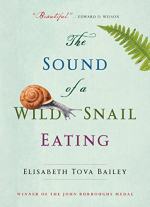|
This section contains 630 words (approx. 2 pages at 400 words per page) |

|
The Sound of a Wild Snail Eating Summary & Study Guide Description
The Sound of a Wild Snail Eating Summary & Study Guide includes comprehensive information and analysis to help you understand the book. This study guide contains the following sections:
This detailed literature summary also contains Topics for Discussion on The Sound of a Wild Snail Eating by Elisabeth Tova Bailey.
The following version of the book was used to create this study guide: Bailey, Elisabeth Tova. The Sound of a Wild Snail Eating. Chapel Hill, NC: Algonquin Books, 2010.
While traveling in Europe, Elisabeth Tova Bailey is taken seriously and suddenly ill. She returns home where her illness confounds medical professionals. When Part One of the book opens, she is convalescing in a small studio, unable to get out of bed. A friend brings her a snail found in the woods and the snail begins to live by Elisabeth’s bedside. Elisabeth starts observing the snail and its presence brings her a sense of companionship. Observing the snail as it moves about the terrarium she has acquired for it makes Elisabeth feel connected to another living creature. A trip to the doctor’s office is not only difficult and physically demanding, but reminds Elisabeth of how cut off she is from normal life and other people.
Elisabeth’s friends visit when they can, but their presence reminds her of the life she has lost. She snail’s presence, comparatively, puts her at ease. Years later, Elisabeth learns about snails and she includes some information about them in the next part of the narrative. They have thousands of teeth, rely only on the senses of smell, taste, and touch, and produce a variety of types of slime for various purposes. A snail can repair its external shell if it is damaged, unlike Elisabeth whose internal skeleton is rapidly decreasing in bone density.
The evolution that resulted in Elisabeth and the snail’s current species relies on various pathogens that rearrange cellular DNA. However, in Elisabeth’s case, the pathogen that took over her body has crippled her, and she wonders who it is reshaping her DNA. Snails are some of the most successful species, having existed for half a billion years. Snails have memory and can retain new information, while prompts Elisabeth to believe that they have the capacity for thought. They can also go dormant by either hibernating or estivating. Elisabeth envies this ability and wishes that she could hibernate until modern medicine catches up with the challenges of her illness.
One morning, Elisabeth sees that the snail has laid eggs. She then writes about the complex and long process of snail copulation. She then feels bereft when the wakes up one morning and cannot find the snail. In the next chapter, a friend finds it in the terrarium among another clutch of eggs. The eggs begin to hatch and the terrarium is soon full with 118 baby snails. Elisabeth’s condition has gradually improved and she is ready to move back to her farmhouse. She gives the original snail to her caretaker and its babies are either distributed to friends or released into the wild.
Elisabeth misses her original snail after moving home, but has decided to release it back into the wild. By autumn, she is well enough to have one of the snail’s offspring come to live with her. It lives with her for the winter before she releases it into the wild in the spring. During that winter, she noticed that her attention span for snail watching decreased as her physical health improved. As time passes, Elisabeth still thinks about her snails and uses them as a reminder to do what she can at whatever pace she can go.
In the Epilogue, Elisabeth writes about her research into snail species and viral pathogens. In the many years of her illness, she has struggled to find a diagnosis, but ultimately found three possible terms for her condition caused by the pathogen that made her ill. Aware of her mortality, she hopes not necessarily that her species will survive, but that life itself will continue to evolve.
Read more from the Study Guide
|
This section contains 630 words (approx. 2 pages at 400 words per page) |

|



